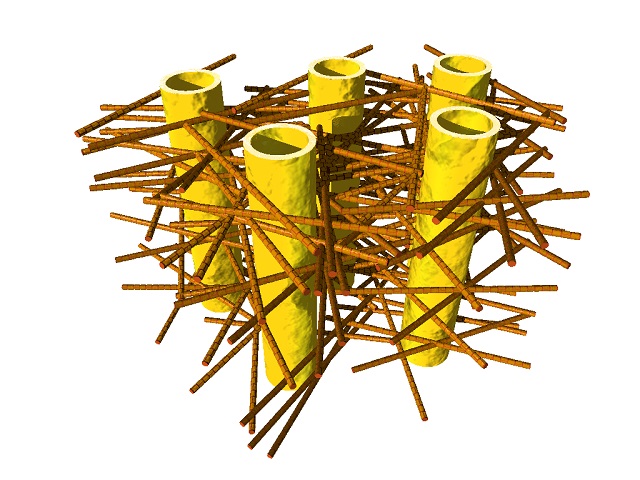 Illustration of the complex biostructure of dentin: the dental tubuli (yellow hollow cylinders, diameters appr. 1 micrometer) are surrounded by layers of mineralized collagen fibers (brown rods). The tiny mineral nanoparticles are embedded in the mesh of collagen fibers and not visible here. (Credit: JB Forien @Charité)
Illustration of the complex biostructure of dentin: the dental tubuli (yellow hollow cylinders, diameters appr. 1 micrometer) are surrounded by layers of mineralized collagen fibers (brown rods). The tiny mineral nanoparticles are embedded in the mesh of collagen fibers and not visible here. (Credit: JB Forien @Charité)
An interdisciplinary team headed by scientists from Charité – Universitätsmedizin Berlin have examined the complicated structure of dentin in human teeth.
Human teeth are designed to last a lifetime irrespective of the number of forces they are subjected to. However, the scientists have still not fully interpreted the high failure resistance of dentin. The scientists at the synchrotron sources BESSY II at HZB, Berlin, Germany, and the European Synchrotron Radiation Facility ESRF, Grenoble, France were able to report precompression of mineral particles. The resistance of the biostructure was increased as internal stress works against the advancement of cracks.
Materials are strengthened by engineers for specific applications using internal stresses. Human teeth, unlike bones partially made of living cells, are incapable of repairing damage. The bulk of teeth is composed of a bonelike material - dentin made up of mineral nanoparticles. These nanoparticles are covered and tightly connected by collagen protein fibers. These kind of fibers can be observed in each tooth in the form of layers, making teeth resistant to damage and rendering them tough. However, the method of preventing crack propagation in teeth is still a mystery.
Recently, researchers from Charité Julius-Wolff-Institute, Berlin and their partners from Materials Engineering Department of Technische Universität Berlin, MPI of Colloids and Interfaces, Potsdam and Technion - Israel Institute of Technology, Haifa are involved in the close examination of these biostructures. By performing Micro-beam in-situ stress experiments in the mySpot BESSY facility of HZB, Berlin, Germany, the researchers analyzed the local orientation of mineral nanoparticles via the nano-imaging facility of the European Synchrotron Radiation Facility (ESRF) in Grenoble, France.
The team also found that the mineral particles attached to the fibers are compressed as the small collagen fibers begin to shrink. Dr. Paul Zaslansky from Julius Wolff-Institute of Charité Berlin explained,
Our group was able to use changes in humidity to demonstrate how stress appears in the mineral in the collagen fibers. The compressed state helps to prevents cracks from developing and we found that compression takes place in such a way that cracks cannot easily reach the tooth inner parts, which could damage the sensitive pulp.
In this way, the stress due to compression avoids any crack formation in the tooth.
They also analyzed the consequences if the tight mineral-protein link was destroyed on heating. The dentin gets weaker in such cases. Charité scientist Jean-Baptiste Forien said,
We therefore believe that the balance of stresses between the particles and the protein is important for the extended survival of teeth in the mouth.
These results help in understanding the failure in performance of artificial tooth replacements as that of healthy teeth. The artificial replacements are more passive and lack certain mechanisms present in the natural tooth. As a result, the fillings cannot withstand the stresses applied in the mouth as well as natural teeth. “Our results might inspire the development of tougher ceramic structures for tooth repair or replacement”, Zaslansky stated.
References